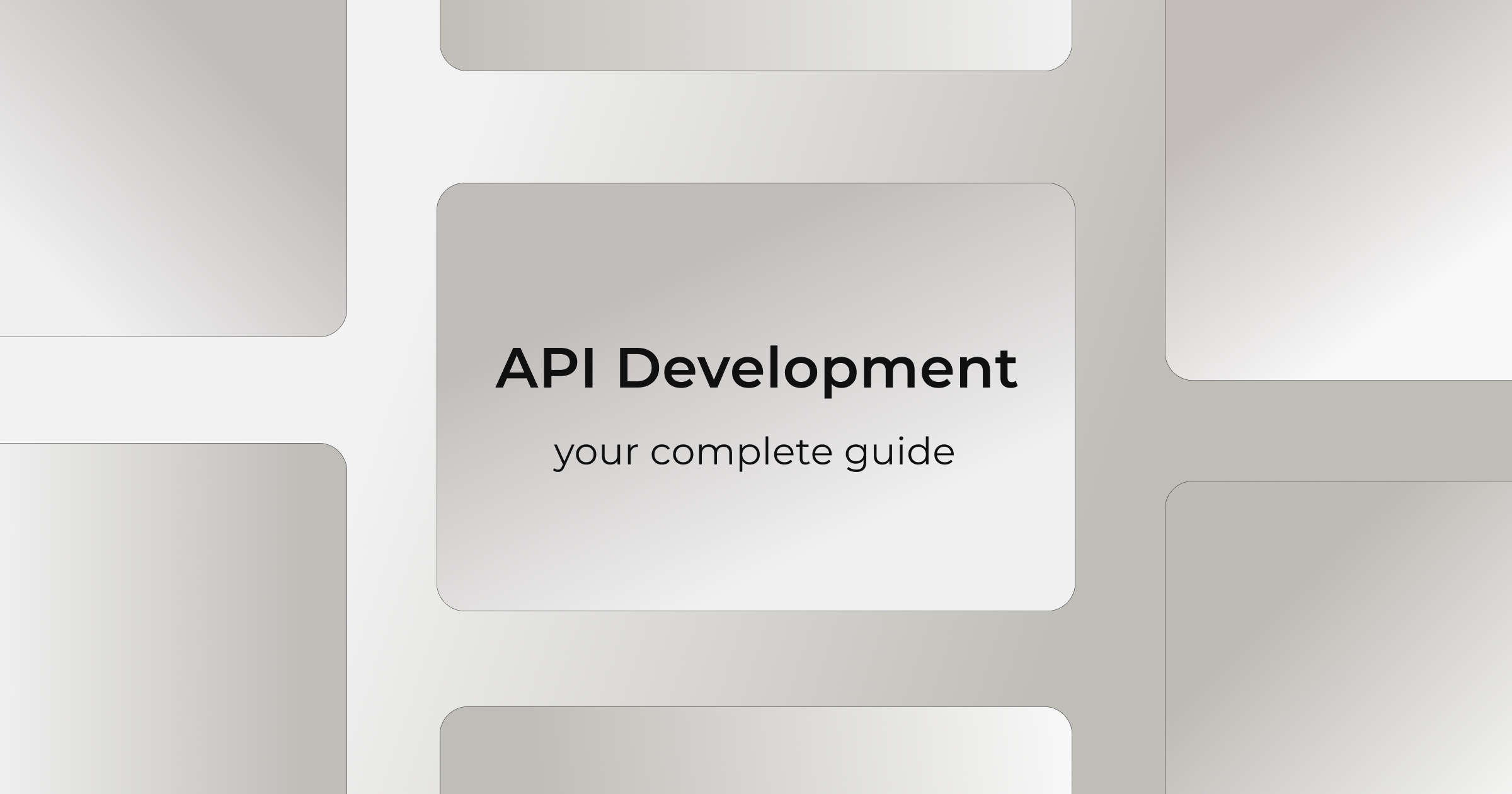
According to Grand View Research, the global API market size was estimated at US$18 billion by the end of 2024 and is expected to reach a record US$49.45 billion by 2030, with a CAGR of 18.9%. Indeed, considering that modern APIs have become full-fledged elements of digital software architecture and are responsible for interaction between individual software modules, it becomes clear that they provide scaling. That’s why we decided to explain the specifics of API development and how to plan it correctly.
Why APIs Are Essential in Modern Development
No modern software today is autonomous: it interacts with external systems, modules, plugins, etc. API is the element that is responsible for these integrations. Without it, you won’t be able to connect a payment gateway, set up the integration of your software with a CRM system (for example), or even synchronize the frontend with the backend, just because even the most primitive mobile app today requires an API at least to receive data and process logic on the server side.
Understanding API fundamentals
In essence, an Application Programming Interface, or API for short, is a software interface for interaction between apps that describes how one of them can request data or actions from another. For example, in the context of backend development, an API makes it possible for the frontend to receive data from a database or, for a mobile app, to send commands to the server. What’s noteworthy is that the API doesn’t have a visual layer – there is only data and logic.
For a company, API development ensures software scalability, as it allows tech teams to save app logic while implementing new integrations.
Key API terminology every developer should know
When designing an API, there are a number of terms that are worth knowing:
- Endpoint, which refers to the specific address where a function or request is called;
- Payload, defining the body of the request or response, usually in JSON or XML format;
- Method, denoting the HTTP method, which indicates what action is being performed: GET, POST, PUT, or DELETE;
- Status code, meaning a numeric code with which the server responds to the client;
- Authentication and authorization, needed to ensure protection through tokens, JWT, OAuth, etc., for public APIs.
How APIs Work: Technical Deep Dive
Now, let's dive into the technical aspects of API implementation.
Request-response cycle and data flow
At the core of any API work is the “request-response” model, according to which a browser/mobile application/external service (or any other client) sends a request to the API to be processed on the server. In parallel, the API accesses a database, logic, or external resource to return the result in a predefined format. Additionally, this procedure may include several intermediate stages, such as validation, authorization, logging, and caching, and therefore, your software’s architecture should provide for all these stages from the very beginning.

HTTP methods and status codes
Each API request is based on one of the HTTP methods: GET (to request data), POST (for creation of a new object), PUT (to update an object), or DELETE (to delete an object). Actually, most REST APIs are based on this. However, during development, it’s important to specify not only the correct method but also the format of the server response (status) – this can be 201 Created, 403 Forbidden, or 500 Internal Server Error.
API endpoints and data formats
An API endpoint is a unique URL that a client accesses to perform a specific action, and which must be related to a specific entity type. The output data format that the API returns is most often JSON (sometimes XML). During development, it is important to specify this in the documentation (as well as the permitted input data types) to reduce the time required for integration and minimize the risk of errors in logic.
Types of APIs and Their Use Cases
APIs can be of different types, so it's important to understand which one will be best for your project's architecture and goals.
Public, Private, and Partner APIs
Let's start with public APIs – they are open to all, and are generally optimal for constantly evolving projects so that developers can work in several teams separately. This type of API requires strict authorization and monitoring. In contrast, you can create a private API, which provides end-to-end control over who and how accesses the data and is used only within one development team. Finally, there are also partner APIs that open access to them only for certain organizations, by API key and by agreement. This type is optimal in the development of white-label software or software that will be transferred within the framework of a franchise.
REST vs GraphQL vs SOAP
REST remains the standard API type due to its simplicity, broad compatibility, and scalability (which is why it is often chosen for corporate projects). There is also GraphQL, which opens up greater flexibility (the client can form the structure of the response) – it makes sense to use it for software with complex logic, when you need to reduce the number of calls. Finally, there is SOAP, which is quite often applied to software for financial management, insurance, or government services, where you need to implement formal contracts and ensure transaction reliability.
Enterprise API applications across industries
As for our experience in API software development, we have implemented APIs in eCommerce, fintech, and marketing platforms. For example, in one B2B project, APIs allowed us to unite communication channels and collect analytics on leads. As a result, this reduced the volume of manual work by 85% and increased the efficiency of the sales team by 60%. You can learn more about this case here.
API Development Tools and Technologies
The modern API development process is impossible without specialized tools. The most popular ones will be discussed below.
Design and documentation tools
During the design phase, we use visual modeling and specification tools with OpenAPI/Swagger support (like Stoplight Studio or Swagger Editor) to define the structure of endpoints, acceptable data formats, and methods before coding begins. We also use documentation solutions (like SwaggerHub and Postman) to define the API contract that becomes the basis for the implementation of the entire project.
Testing and debugging platforms
Once the API coding is complete, we test both the happy path and the boundary conditions/authorization errors/rate limits/response correctness/stability under increased workload. To do this, we implement both unit tests and simulation of end-to-end user scenarios. Tools with mocking, stubbing, and autotesting capabilities (e.g., Insomnia and TestGorilla) come to our aid to reduce bugs and speed up the release.
Development frameworks and libraries
A framework or library for making APIs should support REST or GraphQL standards, be flexible in terms of routing, and ensure authorization, logging, and monitoring. For example, depending on the project, we can use such API development tools as Django REST Framework, FastAPI, or Flask.
How to Build an API: Complete Development Process
API development involves a full cycle of several stages, which we will discuss below.
Planning and requirement analysis
First, we define the entities used, the persons that will utilize the API (internal teams/external users/partners), and the security and scaling constraints. We also figure out non-functional requirements (such as response time, request frequency, and data volume).
Design and architecture decisions
Now, we move on to defining the architectural principles – they can be REST, GraphQL, or SOAP-based. Also, we find out whether authorization is needed, what the structure of the resources is, and what the versioning rules are – all this is necessary to simplify scaling in the future.
Implementation and testing
The API code must be modular and have the ability to be fully covered by error-handling logic. We also provide documentation for each endpoint and test coverage. Finally, we implement overload protection, as well as set request limits, caching, logging, and metrics tracking.
Deployment and monitoring
The API requires monitoring of production behavior, which includes health checks, alerts, performance metrics, error logs, and fast rollback capabilities. The deployment itself must also support updates without downtime and horizontal scaling.
API Development Best Practices for Production
Finally, let's talk about what should be present in a ready-to-launch version of the API.

Security and authentication essentials
APIs are a vulnerable part of the system, especially if they are public – that is why it is so crucial to implement multi-level protection, including token authorization (OAuth/JWT), IP restriction, rate limiting, as well as protection against SQL injections.
Performance optimization strategies
Low response times and stability under heavy workloads are fundamental. They can be achieved through caching (at the request or response level), compression, asynchronous calls, well-thought-out database indexes, and proper pagination.
Documentation and versioning standards
Since good documentation becomes mandatory as the project evolves, it makes sense to use tools with interactive capabilities such as Swagger or Redoc – they provide examples of requests, response codes, and descriptions of business logic. It is also necessary to choose the right solutions for versioning in advance – without them, it will be impossible to make changes in an API without hassle.
API Business Models and Monetization Strategies
If you build a B2B platform, marketplace, or SaaS, the API can serve as a separate source of income.
Usage-based pricing models
According to this model, API access is priced based on the number of calls, the amount of data transferred, or the number of active users. At the same time, it requires built-in monitoring and billing, which must be taken into account in the architecture in advance.
Freemium and premium API tiers
Free basic access to your API allows you to attract developers and partners, while advanced features (such as extended limits, SLAs, or additional analytics) become available only in a paid plan.
Revenue sharing and partnership models
If your platform works with a large number of partners, you should consider a revenue-sharing model. While this requires transparent accounting, it also opens up opportunities to build a solution where increased API traffic will generate higher revenue for all parties.
Overcoming Common API Development Challenges
The difficulty of API development is that errors often appear only when the load increases or external systems are connected. For example, in our practice, we have encountered unstable integrations, errors in business logic, a lack of monitoring, etc. However, all this can be fixed through the correct architecture, testing, and the implementation of versioning standards. The implementation of DevOps practices can also benefit, as it’s always easier to implement CI/CD and logging from the very beginning than to fix difficult-to-fix bugs after an incident.
API Development Cost Considerations and ROI
The cost of API development depends on the complexity of its business logic, the number of endpoints, as well as the requirements for security, monitoring, and fault tolerance. In the simplest cases, developing an API can take about 2-3 weeks for one developer, and in more complex cases, more than 3 months of work for a team of 2-4 people.
As for profitability, it is assessed by how much the API saves team resources, speeds up integrations, increases product stability, or becomes a revenue channel. By the way, if you would like to get the highest ROI from your custom API development, feel free to contact us.
.png)







